14 Bushcraft And Survival Uses For The Billy Pot.
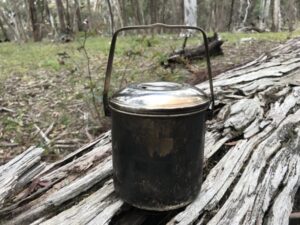
The humble billy pot, has many bushcraft, camping and survival uses. Besides the obvious use of boiling water to prepare a coffee, it can be a container to hold unusual items, or be used as a multi-purpose cooking utensil.
The billy pot is also known as a bush pot, billy tin, billycan and camp pot throughout various parts of the world.
For one of the best Billy Pot for camping and bushcraft, visit Zebra Billy Pot Review.
Here are some different bushcraft, wilderness and survival uses for the billy:
1. Collect rainwater runoff.
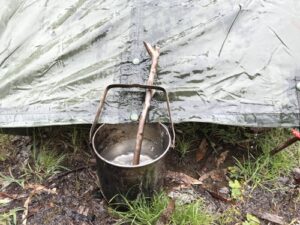
Use the billy pot to help catch rainwater runoff by placing it under a low point of your tarp, tent or shelter.
If the water isn’t being directed into the container accurately, place a stick or adjust the bail handle so it creases the tarp and diverts it into the billy tin.
A poncho, large foliage leaves, dry bag and garbage bags, can also be used to redirect or collect the runoff from the rainwater.
2. Versatile cooking utensil.
Not only is the billy used for brews, the billy is handy to cook up soups, hot pots and camp stews.
Other ways to cook with the billy is to turn it on its side and you can bake cake, bannock or damper.
Add some oats and water in the billy tin and heat it up for a filling porridge breakfast. Or if you don’t want to light a fire, (Or can’t.) soak some oats in water overnight it the pot. Add some native berries (Or sliced apple.) and a touch of cinnamon powder the next morning and enjoy cold. A filling meal that doesn’t require heating.
I have heard of people turning the billy on its side and cooking bacon in it.
Firebox Stove has a video were they cook a whole roast chicken in the bush pot turned on its side. They also show the pot being used for smoking meat.
The billy pot lid can also be used to cook some items. Lids with a curve or deep design can also be used for a makeshift plate or bowl.
Tip. If you use the billy pot for stews, it can get a bit messy. Use some bread or bannock to mop up the leftover and help clean the pot.
Alternatively, pour a little water into the billy and place it back on the fire. Gently heat up the water, and swish it around the pot, cleaning the inside leftovers. The hot water makes it easier to clean. If you are still hungry after the meal, you now have some warm soup and a cleaner pot at the same time.
3. Billy pot survival kit.
Some people store food, or cooking stoves in the billy when hiking, to make use of the dead space when not being used. But, the billy pot can also be a handy container to fit some survival items in it. It could be part of your layered bushcraft and survival kit.
You can fit some cordage, spare small knife, fire lighting tools, Leatherman tool, space blanket, first aid kit in the billy, etc. The bush pot also helps protect items, so ideal for headlamps, or small electrical items, etc. Wrap up items in a bandana, so they don’t rattle and are protected.
The knowledgeable Mors Kochanski in one of his YouTube bushcraft videos, packs a heap of survival gear into the camp pot, even a saw blade and down jacket.
A fishing trotline, or hobo fishing kit with potentially dangerous hooks dangling can be stored safer in the billy tin. With less chance of the hooks getting tangled in your back pack.
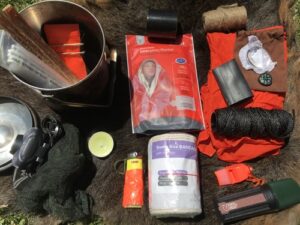
Above pic; Billy pot containing fatwood, water storage bags, signal mirror, headlamp, mosquito head net, candle, lighter, snake bite bandage, SOL space blanket, tape, jute, orange bandana, magnifying glass, button compass, ranger band, mariners bank line, whistle and UCO matches.
4. Foraging container.
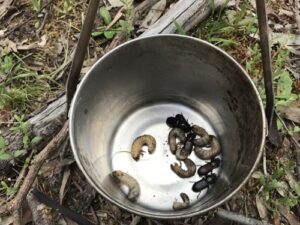
Use the billy to hold edible’s (Or bait.) such as, grasshoppers, crickets, grubs, beetles, etc. Some bugs like wood grubs can chew easily though cloth bags, so the billy tin is ideal.
The billycan is also good as a container when foraging for edible plants. With spikey plants and leaves like thistles, the thorns don’t go through the metal, like a fabric bag might.
Foraging around coastal areas and fresh waters can provide sea weeds, mussels, crustaceans like crabs, crawfish, (Yabbies, crayfish.) etc. Sea urchins with their spikes and shell fish with sharp shells can damage cloth or dry bags, so the billy is handy when foraging around the water’s edge.
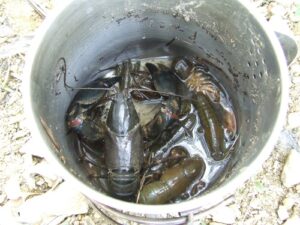
5. Use it for a digging tool.
The better quality brands, like the Mors pot, Pathfinder bush pot and Zebra stainless steel billy pot are solid enough to dig with.
I have used my Kookaburra billy tin and Zebra pot as a makeshift digging tool and it does a good job in looser soils.
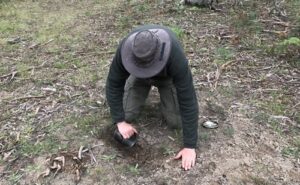
A digging stick with the billy is also an effective combination. Sand is easily and quickly dug, collected and can be poured away in one scoop with the billy.
(I have heard Mors Kochanski mention in one of his bushcraft YouTube videos, say you can dig faster with the billy can than a shovel.)
6. Signal mirror.
Buff and polish the lid, or billy can and you have a crude signaling mirror. While it won’t obviously be as reflective as a proper signal mirror designed for the job, the shiny surface can help in an emergency.
(A mirror on the Silva Ranger SL compass and the Suunto MC-2 compass, could also be used as a signaling mirror.)
Another way to use it in a wilderness rescue situation, is to shine up most of the camp pot and attach it high on a long pole, a sparse tree or on a tripod. The wind will move the shiny billy about, reflecting the sun. (See my Bushcraft and camping tripod uses, article. Space blankets, brightly colored bandanas, ca also be used on the tripod to help catch attention of rescuers.)
7. Mirror for first aid.
Similar to the makeshift signaling mirror, the billy again can be polished up used as a mirror for first aid use. Use it as a mirror and look at facial wounds, back or bottom bits or eyes. (Or if you are just vain and like looking at yourself.)
8. Bucket to collect water.
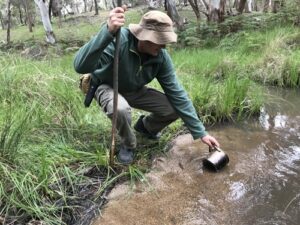
The billy tin can be used to help reach hard to get to places, like collecting water from a deep well or crevice. Tie some rope on the bail handle and lower into the well or hole to collect the water.
Or use it to collect water from dangerous water ways. Like fast flowing waters, or crocodile waterholes. Cut a long stick and carve a figure 7 notch to hold the bail in place and secure with some cordage. Lower into water from a safe distance, or from an elevated position, or from the safety of the side of tree. (Alligators and crocodiles have been known to lie in wait at the water’s edge and ambush animals and humans, which regularly go to the same bank.)
Pour the collected water into another container or dry bags, so you don’t have to go back regularly to collect water. Remember to boil or sterilize the water before drinking.
9. Billy pot, pine needle tea.
For the coffee lovers, there is nothing better than a brew to start the day. For something different, try a pine needle tea. Boil up some water in the billy tin and let it cool a bit. (Too hot of water can kill the vitamin C.) Place a handful pine needles in the billy and let soak. Remove the pine needles and enjoy.
Some people will chop up the needles into small pieces, and soak. This can help the flavor and vitamins absorption. But it takes a little bit more work to strain out the pine needles.
Ensure that you identify the plant 100% correctly. Some toxic plants to look out for are Yew pine (Podocarpus macrophylla) and Norfolk Island pine (Araucana heterophylla).
10. Candle holder.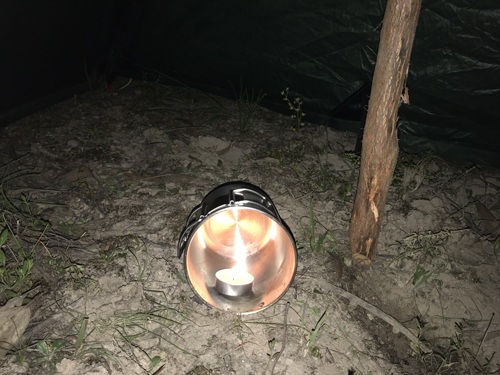
Place the billy tin on its side and place a tea light candle in it. In a tarp shelter, the billy protects the flame from the draft and also makes it a bit safer, if you have a ground sheet close by. (Obviously, never place the candle close to anything flammable, or in an enclosed area.)
If you don’t have tea light candles, but a normal candle, use a bit of sand, pebbles or dirt in the bottom of the billy to hold the candle upright. The bush pot lid and or the bail, can help adjust the angle of the candle / billy pot.
A little bit of heat can be derived from the candle as well.
Some people like the citronella candles and state that it keeps the mosquitoes away. Others say it has little effect on reducing the mosquitoes. Either way a nice ambient light is emitted by the candle. Perfect for lighting a tarp shelter or a Polish Lavvu tent.
11. Scorpion trap.
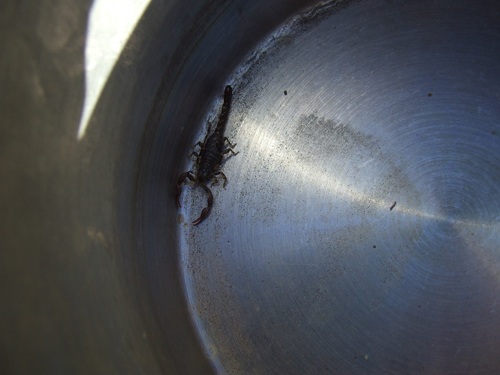
Dig a hole in front of a scorpion hole and place the billy or a cup in front of the hole. Leave overnight and check in the morning. (Les Stroud used this technique in a Survivorman episode.)
Smaller lizards, rodents and other insect can be caught this way as well.
12. Container to transport fire.
An ember on a cattail (Typha.) head, punkwood, pinecones, or certain types of fungus can be used to transport fire from one campsite to the next in the billy.
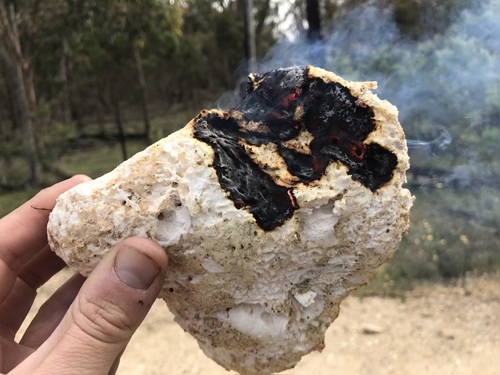
So the ember has oxygen, the billy pot is swung backwards and forwards now and then, to oxygenate the ember. Or blow on it. (Too much oxygen and the tinder will burn out quickly. Not enough oxygen and the ember will die.)
You can also wrap a coal up with grasses, or dried animal dung and wrap with bark, making a long match and place in the billycan. Make sure the coal has just enough oxygen to keep it smoldering.
(An old coffee tin with holes punched in it can also be used to transport the fire.)
13. Char cloth container.
It can be a bit messy, but you can char cloth in the billy pot. Just leave the lid loose enough so the gasses can escape, but on enough, that the material doesn’t catch on fire.
Or put the billy upside down covering the material and build the fire around it.
(If the pot gets dirty from charring, use some water and grasses, leaves, bracken fern, or sand to scrub and polish the billy clean.)
Natural materials like cattails or punkwood, etc., can also be charred for tinder.
Alternatively, you can char some materials without a tin, tinder box, foil or pot. Depending on material used, you can place it in the fire, char it and the pull it out of the fire. Also you can bury materials in the ashes, let it char, then pull it out. Some materials, you may have to smother when pulled out of the fire, so it doesn’t burn or smolder too much.
14. Shrimp and crawfish trap.
Baitfish, crabs and crawfish (Crayfish, yabbies.) can also be caught in the camp pot as a makeshift trap.
Place some bait in the bottom of the billy and some tie some rope on the bail handle. Lower the billy in the water near weed beds, sunken tree limbs, etc. Make sure the cordage is strong and the pot handle has a solid connection, as the container may get snagged trying to pull it up.
(So you don’t risk losing your billy, a hollow log or bamboo, with one end blocked might be a better option. Or if time permits, a natural fish trap made out of reeds or natural materials. But hey, we are covering some different possible uses of the billy tin.)
The bait used could be some worms, insects, fish or animal entrails, etc. So the fish or crawfish doesn’t steal the bait, wedge a small flexible stick in the billy pot sideways to hold the bait in. Or skewer the bait with the stick and wedge sideways.
For catching freshwater shrimp for bait (The bigger ones we cooked.) we used some gum leaves and soap in the container to attract the shrimp. (We used an old bucket or drum with holes drilled in it. The holes help drain the water out when hauling the bucket up. I have heard of fisherman using crushed up Cheetos, cheese cubes, corn, etc. in the bucket for bait.)
Check every half hour, to two hours. Or leave overnight.
Summary – Bushcraft uses for the billy pot.
The billy tin is a versatile cooking item, whether boiling water, making stews or using it as a foraging container to hold edible plants, insects or digging with it.
The billycan is an icon of old time bushcraft and camping and is truly a valuable bit of gear even today.
